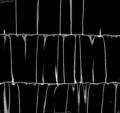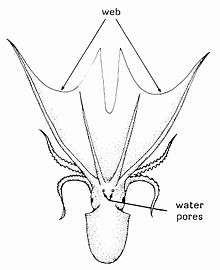Cuttlebone





Cuttlebone, also known as cuttlefish bone, is a hard, brittle internal structure (an internal shell) found in all members of the family Sepiidae, commonly known as cuttlefish, a family within the cephalopods.
Cuttlebone is composed primarily of aragonite. It is a chambered, gas-filled shell used for buoyancy control; its siphuncle is highly modified and is on the ventral side of the shell.[2] The microscopic structure of cuttlebone consists of narrow layers connected by numerous upright pillars.
Depending on the species, cuttlebones implode at a depth of 200 to 600 metres (660 to 1,970 ft). Because of this limitation, most species of cuttlefish live on the seafloor in shallow water, usually on the continental shelf.[3]
The largest cuttlebone belongs to Sepia apama, the giant Australian cuttlefish, which lives between the surface and a maximum depth of 100 metres.
Human uses
In the past, cuttlebones were ground up to make polishing powder, which was used by goldsmiths.[4] The powder was also added to toothpaste,[5] and was used as an antacid for medicinal purposes[4] or as an absorbent. They were also used as an artistic carving medium during the 19th[6][7] and 20th centuries.[8][9][10][11][12]
Today, cuttlebones are commonly used as calcium-rich dietary supplements for caged birds, chinchillas, hermit crabs, reptiles, shrimp, and snails. It is not for human consumption. [13]
Jewelry making
Because cuttlebone is able to withstand high temperatures and is easily carved, it serves as mold-making material for small metal casting for the creation of jewelry and small sculptural objects.
Jewelers prepare cuttlebone for use as a mold by cutting it in half and rubbing the two sides together until they fit flush against one another. Then the casting can be done by carving a design into the cuttlebone, adding the necessary sprue, melting the metal in a separate pouring crucible, and pouring the molten metal into the mold through the sprue. Finally, the sprue is sawed off and the finished piece is polished.[14]
Internal structure
- 3D visualisation of a Sepia cuttlebone by industrial micro-computed tomography
-

3D view of part of a cuttlebone at low resolution.
-

Overview of a part at high resolution, about 5 µm/voxel.
-

Higher magnification.
-

Detailed view at very high magnification. Wall thickness of the vertical structures is about 10 µm.
- Flight through the corresponding tomographic image stacks
-
Flight through the corresonding µCT image stack, section direction about 30°, lateral view.
-
Flight through the corresonding µCT image stack, section direction about 30°, top view.
-
Flight through the aligned image stack, lateral view.
-
Flight through the aligned image stack, top view.
-
Flight through the aligned image stack, top view, magnified section.
See also
| Wikimedia Commons has media related to Cuttlebone. |
References
- ↑ Fuchs, D., T. Engeser & H. Keupp (2007). "Gladius shape variation in coleoid cephalopod Trachyteuthis from the Upper Jurassic Nusplingen and Solnhofen Plattenkalks." (PDF). Acta Palaeontologica Polonica 52(3): 575–589.
- ↑ Rexfort, A.; Mutterlose, J. (2006). "Stable isotope records from Sepia officinalis—a key to understanding the ecology of belemnites?". Earth and Planetary Science Letters. 247 (3–4): 212–212. Bibcode:2006E&PSL.247..212R. doi:10.1016/j.epsl.2006.04.025.
- ↑ Norman, M.D. 2000. Cephalopods: A World Guide. ConchBooks.
- 1 2 "Uses for cuttlebone. The time when it was used as a medicine (1912) - on Newspapers.com". Newspapers.com. Retrieved 2016-01-21.
- ↑ "Do You Know THIS?". The World's News. 1950-07-08. p. 26. Retrieved 2016-01-21.
- ↑ "WESLEYAN ANNIVERSARY.". Portland Guardian and Normanby General Advertiser. 1872-10-17. p. 2. Retrieved 2016-01-21.
- ↑ "CARNIVAL AT NORWOOD.". Evening Journal. 1898-10-24. p. 3. Retrieved 2016-01-21.
- ↑ "Eleanor Barbour's Pages FOR COUNTRY WOMEN". Chronicle. 1942-07-16. p. 26. Retrieved 2016-01-21.
- ↑ "Note Book Cuttlefish". The Register News-Pictorial. 1930-05-17. pp. 3 S. Retrieved 2016-01-21.
- ↑ "INTERESTING HOBBIES Models from Cuttle-fish". The Age. 1950-06-30. pp. 5 S. Retrieved 2016-01-21.
- ↑ "BACK TO SEMAPHORE CELEBRATIONS.". Port Adelaide News. 1929-12-13. p. 3. Retrieved 2016-01-21.
- ↑ "OUT Among The PEOPLE". The Advertiser. 1943-05-12. p. 6. Retrieved 2016-01-21.
- ↑ Norman, M.D. & A. Reid 2000. A Guide to Squid, Cuttlefish and Octopuses of Australasia. CSIRO Publishing.
- ↑ Casting Silver with Cuttlefish
- Neige, P. 2003. "Combining disparity with diversity to study the biogeographic pattern of Sepiidae." (PDF). Berliner Paläobiologische Abhandlungen 3: 189–197.







